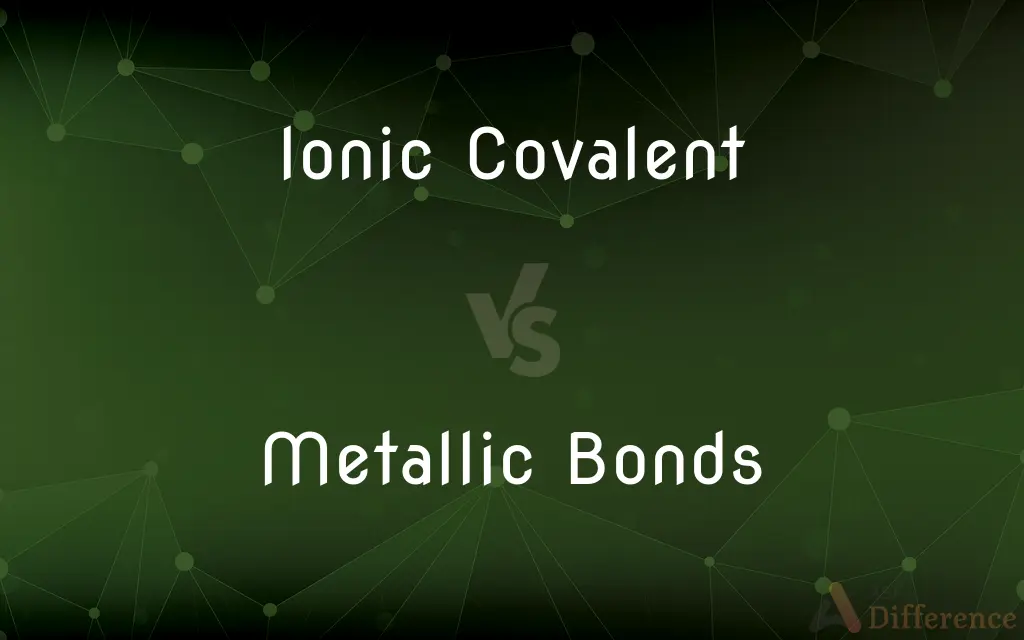Ionic Covalent vs. Metallic Bonds — What's the Difference?
By Tayyaba Rehman — Published on December 15, 2023
Ionic Covalent bonds result from electron sharing between atoms, while Metallic Bonds involve a sea of delocalized electrons among metal atoms.

Difference Between Ionic Covalent and Metallic Bonds
Table of Contents
ADVERTISEMENT
Key Differences
Ionic Covalent bonds and Metallic Bonds represent two primary types of chemical bonding mechanisms. Ionic Covalent bonds are formed when atoms share electrons, ensuring both achieve a stable electron configuration. Conversely, Metallic Bonds manifest in metals where electrons freely move among a lattice of positively charged metal ions.
A characteristic of Ionic Covalent bonding is its occurrence in compounds composed of metals and non-metals. In such interactions, electrons are typically shared to create a stable bond. Metallic Bonds, on the other hand, are prevalent within pure metals, where a "sea" of delocalized electrons results in specific properties like electrical conductivity.
Ionic Covalent bonds generally result in the formation of molecules, both simple and complex. They often exhibit a definite shape and can exist in various phases. Metallic Bonds confer metals with properties like malleability and ductility, allowing them to be shaped without breaking.
In the realm of electrical conductivity, Ionic Covalent compounds in their solid form are typically non-conductive. However, when dissolved or molten, they often become conductive due to the movement of ions. In contrast, substances with Metallic Bonds demonstrate good electrical conductivity because of the freely moving electrons.
In summary, while Ionic Covalent bonds involve the sharing of electrons between atoms leading to molecule formation, Metallic Bonds are characterized by a sea of electrons moving freely within a metal lattice, leading to many of the unique properties of metals.
ADVERTISEMENT
Comparison Chart
Formation Mechanism
Electron sharing between atoms
Delocalized sea of electrons among metal atoms
Typical Occurrence
Compounds of metals & non-metals
Pure metals
Resultant Structure
Molecules with definite shapes
Lattice of positively charged metal ions
Electrical Conductivity (Solid State)
Generally non-conductive
Conductive
Key Property
Formation of molecules with various phases
Malleability and ductility
Compare with Definitions
Ionic Covalent
Electron-sharing mechanism between atoms.
Carbon dioxide showcases an Ionic Covalent bond between carbon and oxygen atoms.
Metallic Bonds
Result in good electrical conductivity.
Iron conducts electricity well because of its inherent Metallic Bonds.
Ionic Covalent
A bond formed by shared electrons.
Water is a molecule formed through Ionic Covalent bonding.
Metallic Bonds
Occur among atoms in pure metals.
Gold, being a metal, exhibits Metallic Bonds among its atoms.
Ionic Covalent
Ensures a stable electron configuration for atoms.
Oxygen atoms form Ionic Covalent bonds to achieve full electron orbitals.
Metallic Bonds
Grant metals properties like malleability.
Silver can be hammered into thin sheets due to its Metallic Bonds.
Ionic Covalent
Results in the formation of stable molecules.
Methane is a product of Ionic Covalent bonding between carbon and hydrogen.
Metallic Bonds
Involve electrons delocalized over a lattice of metal ions.
The shimmering property of metals is often attributed to their Metallic Bonds.
Ionic Covalent
Bonds typically between metals and non-metals.
The bond in sodium chloride is an example of Ionic Covalent bonding.
Metallic Bonds
Bonds characterized by a sea of free-moving electrons.
Copper conducts electricity due to its Metallic Bonds.
Common Curiosities
Which bond results from electron sharing?
Ionic Covalent bonds result from electron sharing between atoms.
Are Ionic Covalent compounds typically electrically conductive in solid form?
No, Ionic Covalent compounds in their solid form are typically non-conductive.
Why do metals like gold have malleable properties?
Metals like gold are malleable due to their inherent Metallic Bonds.
Do Ionic Covalent bonds lead to molecule formation?
Yes, Ionic Covalent bonds lead to the formation of stable molecules.
What gives metals like copper their conductivity?
The Metallic Bonds, characterized by free-moving electrons, give metals like copper their conductivity.
What characterizes Metallic Bonds in metals?
Metallic Bonds are characterized by a sea of delocalized electrons among metal atoms.
Why are Metallic Bonds crucial for electrical conductivity in metals?
Metallic Bonds provide a sea of freely moving electrons, essential for electrical conductivity in metals.
Between which atoms is the Ionic Covalent bond typically formed?
The Ionic Covalent bond is typically formed between metal and non-metal atoms.
What kind of bond exists within pure metals?
Within pure metals, Metallic Bonds exist.
In which compounds are Ionic Covalent bonds generally found?
Ionic Covalent bonds are generally found in compounds of metals and non-metals.
What's the primary difference between Ionic Covalent and Metallic Bonds?
While Ionic Covalent bonds involve electron sharing between atoms, Metallic Bonds feature a sea of electrons moving freely among metal atoms.
How do Metallic Bonds influence the appearance of metals?
The shimmering or lustrous property of metals is often attributed to their Metallic Bonds.
Is the bond in water an example of an Ionic Covalent bond?
Yes, the bond in water is an example of an Ionic Covalent bond.
Why can metals be shaped or drawn into wires?
Due to Metallic Bonds, metals have properties like malleability and ductility, allowing them to be shaped or drawn into wires.
Do Metallic Bonds influence a metal's ductility?
Yes, Metallic Bonds grant metals properties like ductility.
Share Your Discovery

Previous Comparison
Folk Dance vs. Classical Dance
Next Comparison
Arithmetic Sequence vs. Geometric SequenceAuthor Spotlight
Written by
Tayyaba RehmanTayyaba Rehman is a distinguished writer, currently serving as a primary contributor to askdifference.com. As a researcher in semantics and etymology, Tayyaba's passion for the complexity of languages and their distinctions has found a perfect home on the platform. Tayyaba delves into the intricacies of language, distinguishing between commonly confused words and phrases, thereby providing clarity for readers worldwide.
















































